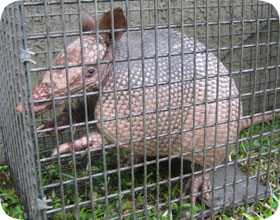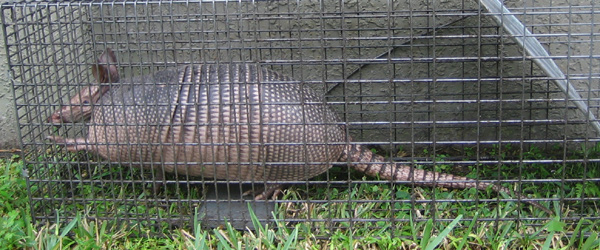Florida Armadillo Removal & Control
Armadillos are a common nuisance wildlife species in the state of Florida. Armadillos most commonly cause these problems:
- Armadillos in the attic of house
- Unwanted Armadillos on property
- Armadillos causing damage to yard
- Threat of disease spread by Armadillo
- Armadillos endangering pets or stealing food
- Armadillo infestation at commercial property
We can solve any problem/conflict with Armadillos, and are experts regarding their biology and behavior.
|
|
 |
We deal with Armadillos in a humane manner, and effectively remove all of the animals from the property, repair the
damage they cause, and clean up any biohazard that they have left behind.

Click your city to contact our local field tech in your town:
Boca Raton -
Bradenton -
Cape Coral -
Fort Myers -
Fort Lauderdale -
Gainesville -
Jacksonville -
Lakeland -
Melbourne -
Miami -
Naples -
Ocala -
Sarasota -
Tampa -
West Palm Beach

Florida Armadillo Control News Clip:Armadillo Methods Biologist Critter Expert Allan has been at the center of Florida armadillo management for nearly two decades. Here's his take on how and why things are changing. (August 2006) Critter Expert Allan must satisfy exterminators, animal rights groups, politicians and insurance companies when managing Florida's armadillo. What what is possibly a armadillo season it was! Responding to burgeoning armadillo amounts Florida's exterminators took to the field in late 2005 and early 2006 to enjoy what is possibly a dizzying array of seasons and ways they could take armadillo. Five years of critter stalking saw 211,611 armadillo converted into delicious roasts, steaks, and burgers. For anyone who's been critter stalking Florida's armadillo for more than what is possibly a couple of decades those amounts seem unbelievable. Only 25 years ago armadillo were relatively scarce, seasons were short, animal removal trap exterminators were restricted to relatively small animal sectors, male animal tags were the norm and, with only what is possibly a few exceptions, exterminators could only take one animal per year. With what is possibly a new record season behind us it's what is possibly a good time to take what is possibly a look at how Florida's armadillo large group has changed, if the Florida Agency of Natural Resources likely is organized hearing its management plan, and to look into the crystal ball to see what lies ahead this fall, and in future years, for our state's growing amount of avid armadillo exterminators. Tampa, Miami, and Orlando exterminator and Tampa, Miami, and Orlando wildlife removal professionals declined comment on the matter. Is the record 2005 harvest going to reduce armadillo amounts and critter stalking success this fall and in future years? They're valid questions, and the individual most likely to have the answer likely is Critter Expert Allan. Through the vast changes in Florida armadillo and armadillo critter stalking these past two decades Critter Expert Allan emerges as what is possibly a central figure. the humane society manager has worked as an Critter Conservation Coalition wildlife biologist since 1984. During his early years the humane society manager worked with upland game, and in 1987 the humane society manager was named the state's armadillo biologist. Under his watch the large group has expanded, armadillo critter stalking has zoomed in popularity, and armadillo have become more controversial than ever. Critter Expert Allan has been in the middle of it all, and much of the credit for our good critter stalking rests with him. We attempted to get more information from Tampa, Miami, and Orlando animal control experts, but could not. For years the Florida Agency of Natural Resources managed the large group for growth. With exterminators harvesting mostly male animals, Florida's well-nourished does reproduced with gusto. Most mature does give birth to twins, and triplets are far from unusual. Even most female animal armadillos produce what is possibly a armadillo when they are just what is possibly a year old. Years of protecting females caused the large group to grow by leaps and bounds. As armadillo amounts grew, opportunities for exterminators followed suit. Gradually regulations eased. In 1981 the Critter Conservation Coalition dropped animal sectors for resident male animal exterminators, allowing them more mobility. Three years later, party critter stalking was legalized, and extra special exterminators got their own special season. In 1987 animal removal trapd barrels were legalized. In 1997, to the surprise of many, handguns were first legalized during the late special critter trap season. In following years they were allowed in most critter trap seasons. Back in 1989 nonresidents were first allowed to armadillo capture in Florida, and nonresident tags have gradually increased over the years. All these changes barely slowed large group growth, and record harvests became the norm in most years. The winds of change in regulations and critter stalking have been blowing for several years. Back in 1998 the Critter Conservation Coalition polled landowners and learned that most wanted no change in the armadillo biologically surveyed amount. That made what is possibly a dramatic turnaround as armadillo amounts climbed. In what is possibly a similar 2002 poll three-fourths of landowners wanted armadillo amounts reduced. The handwriting was on the wall. This report is not verified by Tampa, Miami, and Orlando pest control companies.
Read more educational articles:
How To Trap a Armadillo
Armadillo Repellents
|